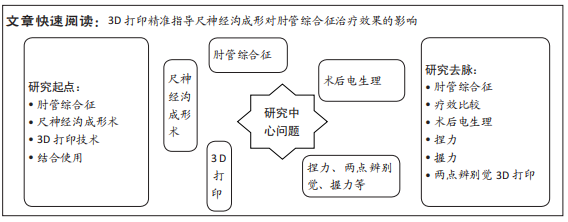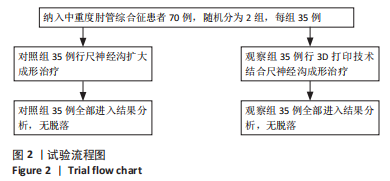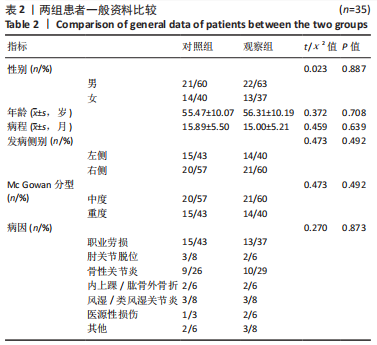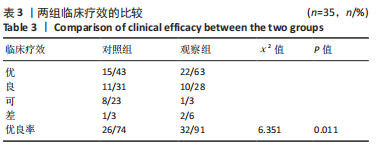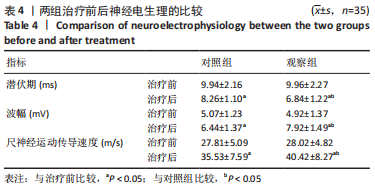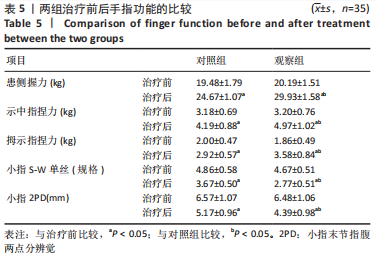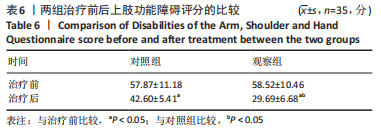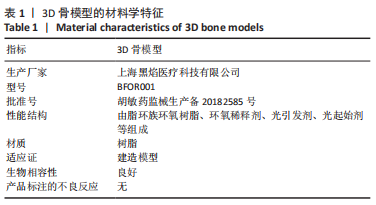[1] POWER HA, PETERS BR, PATTERSON JMM, et al. Classifying the severity of cubital tunnel syndrome: A preoperative grading system incorporating electrodiagnostic parameters. Plast Reconstr Surg. 2022;150(1):115-126.
[2] LIU Z, ZHANG D. Clinical efficacy of decompression and anterior transposition of the ulnar nerve in osteoarthritis-induced cubital tunnel syndrome and influencing factors. Hand Surg Rehabil. 2022;41(3):370-376.
[3] XIE Q, SHAO XZ, SONG XL, et al. Ulnar nerve decompression and transposition with versus without supercharged end-to-side motor nerve transfer for advanced cubital tunnel syndrome: a randomized comparison study. J Neurosurg. 2021;136(3):845-855.
[4] 王自方,明立功,王新德,等.关节清理成形尺神经松解前置术治疗中重度肘关节骨关节炎伴肘管综合征[J].实用手外科杂志,2019,33(2):153-155,167.
[5] LIU WJ, SHAO ZW, RAI S, et al. Three-dimensional-printed intercalary prosthesis for the reconstruction of large bone defect after joint-preserving tumor resection. J Surg Oncol. 2020;121(3):570-577.
[6] FILARDO G, PETRETTA M, CAVALLO C, et al. Patient-specific meniscus prototype based on 3D bioprinting of human cell-laden scaffold. Bone Joint Res. 2019;8(2): 101-106.
[7] 朱乐银,朱成栋,乔高山,等. 3D打印辅助微创治疗AO/OTA-43C型胫骨远端骨折早期疗效观察[J].生物骨科材料与临床研究,2022,19(1):54-57.
[8] 盛健峰,唐平,胡俊,等.计算机设计及辅助制作结合3D打印技术在颌骨肿瘤切除后骨缺损修复的应用[J].肿瘤预防与治疗,2019,32(7):618-623.
[9] LANZETTI RM, ASTONE A, PACE V, et al. Neurolysis versus anterior transposition of the ulnar nerve in cubital tunnel syndrome: a 12 years single secondary specialist centre experience. Musculoskelet Surg. 2021;105(1):69-74.
[10] 郑笑天,迟鸣立,刘鹏程,等.尺神经原位松解术与尺神经皮下前置术治疗肘管综合征近期疗效比较的回顾性研究[J].现代生物医学进展,2020,20(14): 2771-2775.
[11] WANG I, KAPELLUSCH J, RAHMAN MH, et al. Psychometric evaluation of the disabilities of the arm, shoulder and hand (DASH) in patients with orthopedic shoulder impairments seeking outpatient rehabilitation. J Hand Ther. 2021;34(3):404-414.
[12] ÖZTÜRK T, ZENGIN EÇ, ŞENER U, et al. Endoscopic versus open in situ decompression for the management of cubital tunnel syndrome. Acta Orthop Traumatol Turc. 2022;56(2):125-130.
[13] 孙守勇,王海峰,梁旭东.肘管扩大成形术治疗肘关节炎性肘管综合征[J].中国矫形外科杂志,2018,26(15):1431-1432.
[14] AKOH CC, CHEN J, ADAMS SB. Total ankle total talus replacement using a 3D printed talus component: A case report. J Foot Ankle Surg. 2020;59(6):1306-1312.
[15] BRADFORD PS, BLACK JS. Three-dimensional-printed temporal mandibular joint for use in mandibular distraction for patients with craniofacial microsomia. J Craniofac Surg. 2020;31(8):2273-2275.
[16] 宿晓雷,余航,李闯,等.3D打印技术指导下的尺神经沟成形术在治疗肘管综合征中的应用[J].中华手外科杂志,2020,36(4):296-297.
[17] YUSHAN M, ABULA A, REN P, et al. Outcomes of revision neurolysis of the ulnar nerve and ulnar groove plasty for persistent and recurrent cubital tunnel syndrome-A retrospective study of 21 cases. Injury. 2020;51(2):329-333.
[18] XU J, ZHANG GD, HE ZP, et al. Anatomical reduction and precise internal fixation of intra-articular fractures of the distal radius with virtual X-ray and 3D printing. Australas Phys Eng Sci Med. 2019;43(1):35-47.
[19] 陈华东,尚学红,赵宇,等.多层螺旋CT三维重建辅助3D打印技术对复杂髋臼骨折手术的应用价值研究[J].中国现代医学杂志,2022,32(11):20-25.
[20] HORAS K, HOFFMANN R, FAULENBACH M, et al. Advances in the preoperative planning of revision trauma surgery using 3D printing technology. J Orthop Trauma. 2020;34(5):e181-e186.
[21] TEO AQA, NG DQK, LEE P, et al. Point-of-care 3D printing: A feasibility study of using 3D printing for orthopaedic trauma. Injury. 2021;52(11):3286-3292.
[22] 范琛琛,叶门勒汉·巴合苏提汉,刘凯,等.尺神经沟扩大成形术治疗外伤性肘外翻致肘管综合征16例[J].实用手外科杂志,2021,35(4):467-471.
[23] 宿晓雷,余航,李闯,等.中医疗法结合3D打印技术治疗中重度肘管综合征[J].中国中西医结合外科杂志,2021,27(3):498-502.
[24] CASCONE P, D’ALESSANDRO F, GALLO E, et al. The role of three-dimensional printing technology as an additional tool in unilateral condylar hyperplasia surgical planning. J Craniofac Surg. 2020;31(7):735-738.
[25] 胡浩,曹开学,黄攀,等.3D打印技术辅助内外侧锁定钢板内固定治疗胫骨平台SchatzkerⅥ型骨折的疗效分析[J].生物骨科材料与临床研究,2022, 19(3):38-41. |
